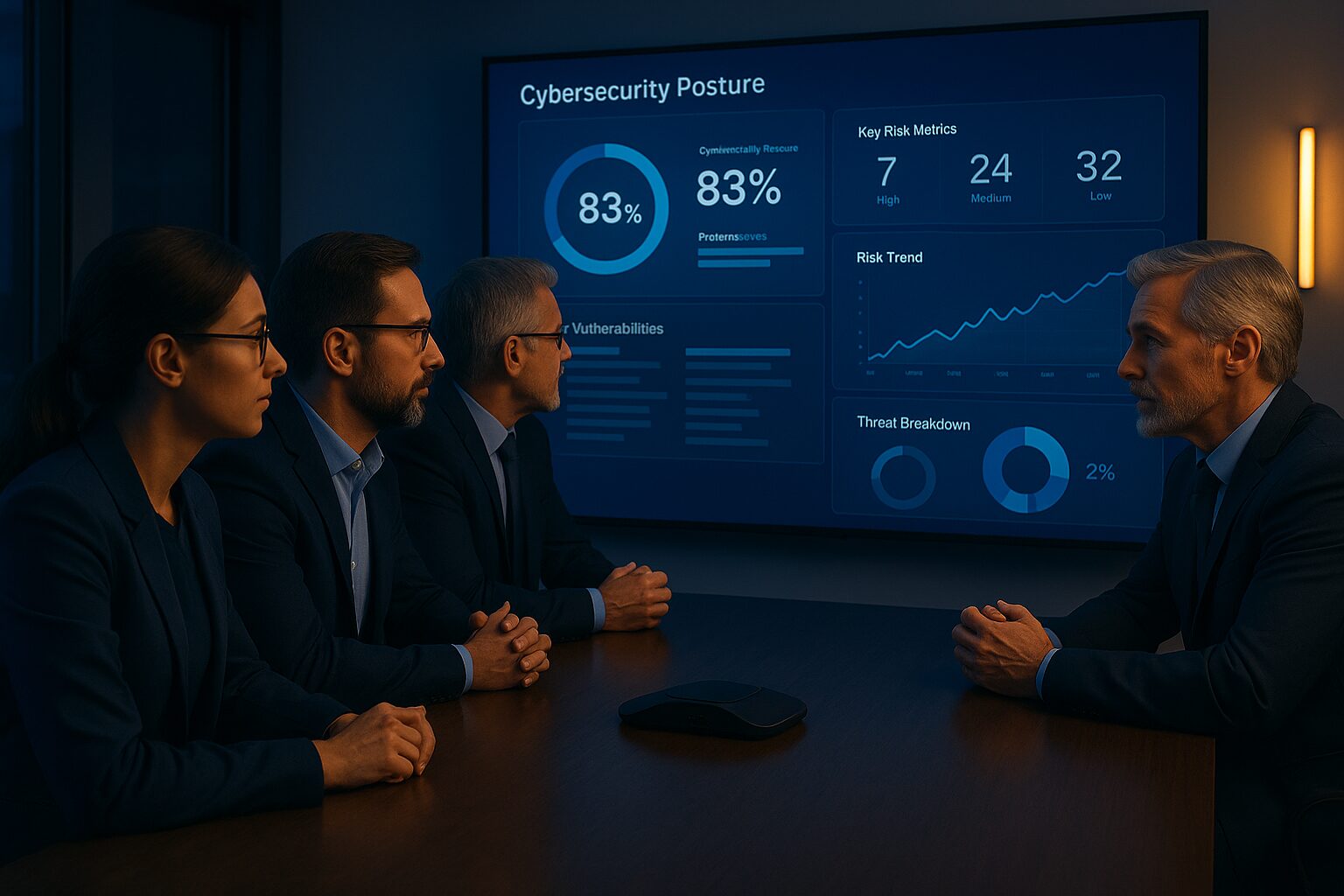Organizations have a lot on their plate, but cybersecurity has to be on their top of every company’s priority list. This article why cybersecurity is so important.
What is Cybersecurity?
The breakneck speed of technological advances highlights the importance of cybersecurity measures. With these advances come cyber threats increasing in numbers and sophistication. As a result, companies need vigilant, adaptable practices that can evolve with the digital landscape.
This blog explores the importance of cybersecurity and examines emerging threats. Most importantly, this blog also outlines how to fortify your company’s defenses against cyber attacks.
Cybersecurity is the application of practices and procedures to protect valuable business data and systems. Information security is instrumental in preventing attacks that could disrupt or disable your company’s operations.
Mitigating risks and vulnerabilities means protecting your data, devices, and networks from unauthorized access, use, or destruction.
Ultimately, the best defenses against cybersecurity threats uphold business assets’ integrity, availability, and guaranteed confidentiality. A durable strategy provides a solid security posture against hackers who exist to access, extort, destroy, or alter systems and sensitive data.
Why Is Cybersecurity Important?
Cybersecurity is important to strengthen companies against a cyberattack that could disrupt operations, create downtime and hurt productivity. Building a vigorous strategy ensures your company swiftly detects and responds to attacks while maintaining operational continuity.
With the importance of cybersecurity on the rise, it is essential to rely on a security-first approach to protecting sensitive information. The internet and technology filter through many aspects of society, and criminals are equally alert to wreak havoc.
These significant risks mean proactively protecting data, networks, and computer systems from damage and theft. Without a tailored security program, it is difficult to defend your company against data breaches and other irresistible targets for hackers.
Covering all the areas that make your company a target is necessary. This requires having more than firewalls and antivirus software installed on your networks and devices. Cybercriminal tactics are proving to be resilient to the usual cyber defenses.
This raises key reasons why a robust cybersecurity strategy is crucial for your company.
• Protect sensitive data – Protecting business data, including intellectual property, is a primary reason to invest in a robust digital security solution. A cyber attack can lead to a data breach with severe consequences such as reputation damage and financial losses.
• Avoid expensive disruptions – Being held accountable for keeping customer data safe is an important consideration. Beyond network slowdowns and lost productivity, your company could suffer other financial losses, such as fines and lawsuits.
• Build customer trust – Demonstrating that your company is committed and actively monitoring security threats can help to build trust, loyalty, and long-term relationships with your customers. Otherwise, relationships weaken if customers do not believe your company can protect their personal information.
• Maintain regulatory compliance – Housing sensitive information subjects companies to compliance with regulatory standards. Non-compliance can lead to penalties and hefty fines. Developing a security policy and investing in a program that helps you stay compliant can prevent potential legal issues.
• Gain a competitive advantage – Prioritizing a secure digital environment helps you to stay ahead of market competitors. Robust measures to keep your data and information systems safe minimize the risk that cyber threats pose. You stay focused on core competencies that give you a competitive edge.
• Secure hybrid work environments – Many threats are external, but changing workforce patterns introduce internal threats. Employees have the option of working in the office or at home. They may access your company network from home offices and mobile devices. Security protocols and controls such as authentication technology help you monitor who is accessing systems to ensure login credentials are accurate.
Cybersecurity Threats
Malicious attacks designed to gain unlawful access to data or disrupt operations can originate from different bad actors. Defending computer systems and networks against these myriad of cyber threats is a continuous task for cybersecurity professionals.
Effectively dealing with these pervasive dangers requires understanding the different types of threats. The following is not an exhaustive list but does highlight some of the current types of cyberattacks.
Advanced Persistent Threats
As the name implies, advanced persistent threats (APT) occur when cybercriminals covertly infiltrate a network. They manage to stay undetected for a long time to monitor, intercept and steal data.
Some manage to exploit vulnerabilities in the software a company uses. Often, their way in is through social engineering tactics with the goal of stealing sensitive information for financial gain.
This requires a remediation technique that protects your company against an APT threat.
Distributed Denial of Service
A distributed denial of service (DDoS) attack pertains to targeting a specific website, server, or other network avenue to disrupt traffic. By using multiple systems, criminals send a deluge of fake messages, packets, or connection requests. This either slows down or crashes the system.
Legitimate user access is blocked while attackers try to disrupt operations for various reasons, such as:
• Insider revenge after an employee termination
• Nation-state activities
• Sabotage by an industry competitor
Malware
A malware attack is a type of malicious software that uses a file or program to bring chaos to a computer network. Some of the common types of malware include:
• Bots
• Spyware
• Trojans
• Worms
• Viruses
• Adware
Once a hacker installs malware onto a computer, they can monitor how the computer is used. The software sends confidential information to the hacker. It also helps the hacker penetrate other areas of the network.
Man-in-the-Middle
Also referred to as MITM, a man-in-the-middle cyber attack breaches a computer system to eavesdrop on the network’s activities. The name is derived from the attackers positioning themselves in the middle of two-party communications. This can be communication between users, computers, or networks.
Although difficult to detect, you can protect your company by having strong encryption measures on all access points within the network.
Phishing
Phishing attacks are executed by bad actors who send fraudulent emails that contain a link to a malicious website. Typically, the email will stress an urgency to respond. If a user clicks on the link, they open the gateway for the cybercriminal to illegally access sensitive information.
Through a malicious download, the network gets infected with malware before the target company becomes aware of the problem. Before detection and remediation takes place, the criminals have already sent the same infected link to others within the same company.
Social Engineering
Like other cyber attacks, social engineering relies on unwitting human participation. This attack tricks users by convincing them to break security protocols. A successful attack gives bad actors access to sensitive data that is otherwise protected.
Using psychological manipulation can take on many forms, such as phone calls, email phishing, or physical access to an office building. Basically, any medium people use to communicate can be exploited by criminals seeking to harm.
Hacking-as-a-Service
While advancements in technology are good for business, it is also bad for those in the business of breaking the law. The convergence of economic downturns and a lower barrier to entry has given way to hacking-as-a-service platforms.
More people are turning to cybercrime to pay their bills. Additionally, unskilled threat actors can participate in low-level attacks by using easily accessible frameworks.
A vigilant workforce can help your company avoid a ransomware attack. Make sure your employees are trained to recognize suspicious activity.
Ransomware
Ransomware continues to run rampant by holding systems hostage until the victim pays the ransom. During this attack, the cybercriminal uses vulnerabilities to send malware that their target downloads.
The target exposes the network through either a website or an email attachment before realizing an attack has occurred. In some cases, multiple computer systems on the network are penetrated by the ransomware. Once the encryption is initiated, all infected computers are simultaneously attacked.
A vigilant workforce can help your company avoid a ransomware attack. Make sure your employees are trained to recognize suspicious activity.
SQL Injection
A SQL (structured query language) injection occurs by infecting a server with malicious code. This common method takes advantage of websites that use SQL queries to extract information from databases. Without the user knowing, attackers inject a malicious command where a normal command usually takes place.
If this type of attack is successful, several problems may arise, such as deletion, modification, or release of important data. Additionally, a SQL injection gives the attacker administrator rights to interrupt normal functions.
Passwords
As one of the primary access verification tools, hackers may enjoy deciphering user passwords. They use such tactics as social engineering, infiltrating a password database, or guessing.
Whether they figure it out on their own or pay someone else, cybercriminals especially look for passwords that are not encrypted.
This is another opportunity for training to ensure your employees use strong passwords. Once an attacker figures out the correct password, they gain access to the same information as authorized users.
URL Interpretation
Another cybercrime attackers commit is altering or fabricating URL addresses. Also referred to as URL poisoning, attackers will use this cyber threat to access professional and personal data. They interpret the syntax of webpage URL information to learn how to access unauthorized areas.
Generally, avoiding this type of attack requires secure authentication methods such as randomly chosen password characters or multi-factor authentication.
Types of Cybersecurity
One thing that makes cybersecurity problematic is the increasing sophistication of cybercrimes. As risks continue to evolve, companies must remain vigilant in staying abreast of the latest attacks.
In practice, this requires that you implement precautions to keep computer systems, mobile devices, and other connections to your network secure. Keeping all elements of your cyber security strategy updated can help to protect your company from vulnerabilities.
The following is a list of some common practices to keep your company’s information safe.
Network Security
Network security is an overarching term used to describe keeping the networking infrastructure protected from theft, misuse, or unauthorized access. Cybersecurity professionals must create a secure infrastructure for all the users, applications, and devices connected to your network.
An example of this is a firewall that monitors the network for all incoming and outgoing traffic. Based on defined security rules, the traffic is either allowed or blocked from the network.
Cloud Security
More companies use cloud computing, which requires greater security protocols for the cloud. A solid security strategy considers the policies, controls, services, and solutions that protect the entire cloud deployment of data, applications, and infrastructure.
Application Security
Identifying and minimizing or eliminating security vulnerabilities is essential for any strategy. In particular, application security uses practices to test current security features within your company’s apps. Exposing vulnerabilities allows you to fortify your defenses against threats.
For instance, a hardware application security measure that uses a router prevents attackers from viewing the IP address of computers on your network. Other examples include encryption and antivirus programs to thwart unauthorized user access.
Critical Infrastructure Security
Protecting assets, networks, and systems encompass critical infrastructure security. Without either of these components, most companies will have a difficult time functioning properly. The same is true for the public safety and economy of a nation.
Some attacks pose threats to water systems, energy systems, and food systems. Through sophisticated attacks that may support espionage, cybercriminals may extract intellectual property of significant value to a company or nation.
Endpoint Security
Endpoints such as mobile devices, laptops, and desktops that are connected to your network must be secure from cyber attacks. Traditional antivirus software programs can no longer guard against the sophistication of malware or other criminal tactics.
An endpoint security measure can protect these end-user devices from malicious campaigns to exploit vulnerabilities.
Internet of Things
Using Internet of Things (IoT) devices to optimize and automate processes helps you improve productivity and operational efficiency. As a security measure, IoT helps to safeguard cloud-connected devices as data transfers from a device on the network to the cloud.
Some measures include encrypting data, implementing better password protection controls, and coding actions to shield devices from scanners and other tools used by hackers.
Industries That Benefit From Cybersecurity Measures
No company is immune from the threats cybercriminals pose to their operations and customer data. Although many threats have a global reach, some industries must build defenses against specialized bad actors who target specific companies.
Financial Services
Financial institutions vary in size, but the global threat to its systems is wide-ranging. Whether banking, investment products, insurance providers, or credit and financing organizations, cybercriminals are waiting to exploit sensitive information.
Therefore, a solid cyber security strategy is pertinent to protect financial records and ensure institutions remain compliant. Security measures such as threat detection and response can aggressively monitor unauthorized access and promptly thwart an attack.
Government Agencies
Government agencies are probably the largest repositories of sensitive data. Whether documents related to national security or fingerprints and contact information on citizens, a breach can have dangerous consequences.
Fighting back against state-sponsored actors means having powerful cybersecurity tools that protect complex infrastructures and networks.
Healthcare
Hospitals and healthcare providers continue to embrace technologies and connectivity advances that help improve patient care. At the same time, their entire digital networks are exposed to greater risks of security breaches.
Safeguarding sensitive information about patients involves a variety of cybersecurity measures to protect:
• Protected Health Information
• Employee data
• Operational capacity
Maintaining an ability to adhere to regulatory compliance is also crucial. Nevertheless, providers can meet these formidable challenges with proper security controls for internal and external cyber attacks.
Retail
Ransomware is a major concern for retailers. The nature of the industry is storing large quantities of customer data, including processing payments from debit or credit cards. Accessing these sensitive details is a prime target for cybercriminals.
With the right balance between efficient operations and security measures, retailers can implement solutions seamlessly integrating with day-to-day activities. Training employees to follow strict policies and protocols adds another layer of protection.
Small and Medium-Sized Businesses
Typically, small and medium-sized businesses (SMBs) are not pressed to protect as much data as their larger counterparts. Still, they need protection from data thefts and cyber attacks because these vulnerabilities can leave SMBs exposed in two ways.
First, criminals tend to view SMBs as easy targets since most do not have security protocols like large corporations. Second, some SMBs have a harder time recovering from financial losses after an attack.
However, smaller budgets should not dictate how a business protects itself from bad actors. Beginning with vulnerability assessments and penetration testing, SMBs can identify cyber security priorities and implement a plan to reduce risks.
Trust Meriplex With Your Cybersecurity
Building a solid defense against network and system security attacks begins with straightforward solutions tailored to your company’s needs. The cybersecurity professionals at Meriplex have the certifications to develop a strategic and tactical program to minimize your exposure.
Once we identify your toughest challenges, we can deliver innovative managed security solutions. Our industry-leading technologies and support can reduce risks, protect against cyber threats, and improve data security.
If you want to learn more about our dynamic and effective approach to keeping your company protected, contact our cybersecurity experts today.



